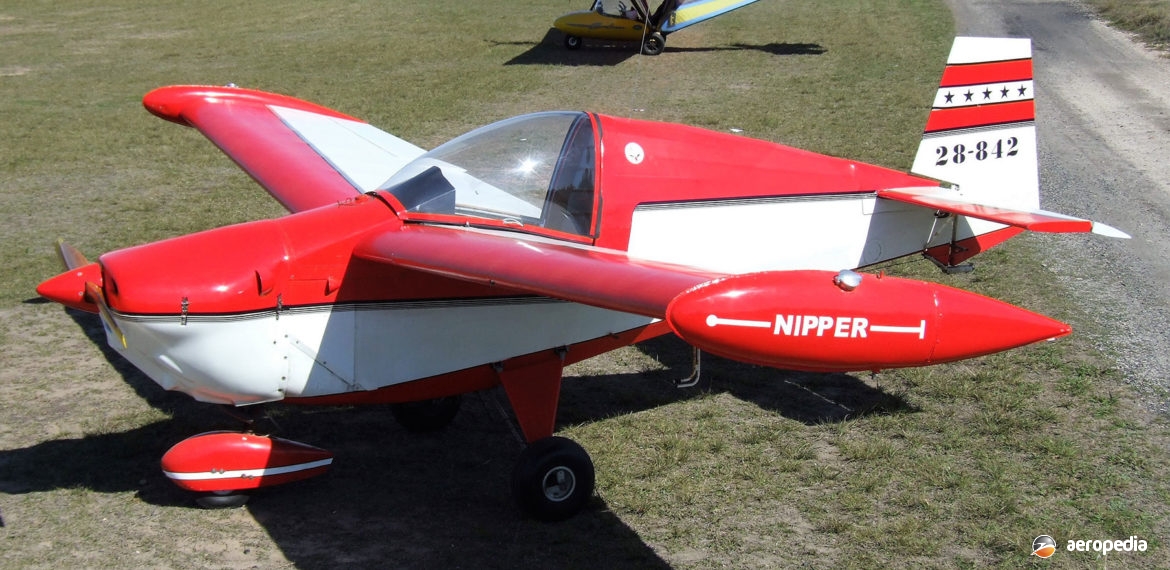Photograph:
Tipsy T-66 Nipper 28-0842 (1630/S123) at The Oaks, NSW in September 2006 (David C Eyre)
Country of origin:
Belgium
Description:
Single-seat light sport monoplane
Power Plant:
One 34 kw (45 hp) Stark Stamo 1400A four-cylinder horizontally-opposed air-cooled engine
Specifications:
- Wingspan: 6 m (19 ft 8 in)
- Length: 4.56 m (15 ft)
- Height: 1.19 m (6 ft 2 in)
- Wing area: 7.5 m² (80.7 sq ft)
- Max speed: 162 km/h (101 mph)
- Max cruising speed: 150 km/h (93 mph)
- Economical cruising speed: 135 km/h (84 mph)
- Stalling speed: 57 km/h (35 mph)
- Rate of climb at sea level: 192 m/min (630 ft/min)
- Service ceiling: 4,000 m (13,100 ft)
- Range with max fuel and 30 mins reserve: 320 km (200 miles)
- Empty weight: 187 kg (412 lb)
- Loaded weight: 300 kg (660 lb)
History:
The Nipper was designed by Mr E O Tips, who was managing director of Avions Fairey SA in Belgium. Previously Mr Tips had designed the Tipsy S, Tipsy B, the Belfair, Primer Trainer, and the Junior. Aimed at the amateur construction market, the Nipper was extremely simple to complete, with the metal parts being supplied as a kit, leaving only minor glueing, carpentry, and fabric covering to be executed by the purchaser.
A semi-aerobatic aircraft, the prototype of the Nipper was flown for the first time on 16 February 1959, and the first production machine was flown on 20 October 1959. Powered by a converted Volkswagen engine, the wing consisted of a single-spar, with constant cross-section and plywood box form, reinforced at the corners by wooden strips. The ribs were traditional Warren girders with spruce capping strips and braces assembled between glued plywood gussets. The fuselage was constructed of conventional steel-tube framework with light wooden formers and stringers to give shape to the fabric covering. The alloy fuel tank formed the coaming in front of the cockpit, and fibreglass was used for the engine cowling panels, the spinner and the access panel under the cockpit. The tricycle undercarriage consisted of tubular tripods hinged at the lower longeron and attached to a central shock absorber bungey under the fuselage.
Only a few Nippers have been seen in the Australasian region. VH-CGA (c/n 36) was a T-66 Mk II first registered in January 1961 and became VH-CGB in November 1966 when c/n 35 was sold overseas. VH-CGB (c/n 35) was also a T-66 Mk II, first registered in May 1961 and was exported to New Zealand on 1 June 1961, becoming ZK-CAP to Aircraft Hire of Masterton. However, on its second flight the propeller spinner detached, shattering a propeller blade, and a forced landing was made into a paddock near Hood aerodrome, damaging the undercarriage. It was repaired and was flying five months later. It was placed on the market but was not sold. On 20 November 1962 it was exported to Australia, becoming VH-CGA, later being transferred to the RAA Register as 28-0476.
VH-CCH (c/n 56) was a T-66S Mk II first registered in July 1963 but was exported to the United Kingdom in April 1964. VH-EOK (c/n 123) was a British-built example, known as the Slingsby T-66-3, and was first registered in Australia in 1969. This latter aircraft was on display at Airworld at Wangaratta, VIC until the museum closed in 2002. It was subsequently sold, being transferred to the RAA register as 28-0842. In more recent times it has been re-built, fitted with a Jabiru 2200 engine, and has been based at The Oaks, west of Sydney, NSW. As at mid-2007 two appeared on the RAA register, 28-0842 (c/n 1630/S123 – ex VH-EOK, G-AWJG) and 28-0476 (c/n 35).
The Nipper has been marketed in kit form by Nipper Kits & Components of Kent in the United Kingdom. It has been produced in a variety of versions and could be fitted with optional wing-tip fuel tanks which increased capacity to 63.6 litres (14 Imp gals). The Mk IV variant was fitted with a 60 kw (80 hp) Jabiru 2200 engine, whereas the Mk III was fitted with a conversion of the Volkswagen series. More than 100 kits have been sold around the world. Construction was of wood, similar to the original production batch produced in Belgium. A kit has been imported to New Zealand and was under construction in late 2015.

